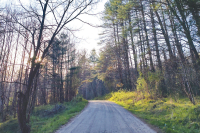History comes to life through food, music and camaraderie
 Standing atop the 5,000-foot Cataloochee Ranch mountain retreat in Maggie Valley, the vastness and endless beauty of Western North Carolina stretches out before your eyes. Heading towards the main building, you reach for the doorknob and enter eagerly. Soon, your body, mind and soul are soaked by the sounds of friends, strangers and old-time string music.
Standing atop the 5,000-foot Cataloochee Ranch mountain retreat in Maggie Valley, the vastness and endless beauty of Western North Carolina stretches out before your eyes. Heading towards the main building, you reach for the doorknob and enter eagerly. Soon, your body, mind and soul are soaked by the sounds of friends, strangers and old-time string music.
Stepping down: Aumen’s departure marks end of an era for Haywood TDA
 Editor’s note: Alice Aumen has been a major voice in Haywood’s tourism landscape for more than half a century — as a founder of Cataloochee Ski Area, operator of the third-generation family-run Cataloochee Ranch and a leader in the Maggie Valley Chamber of Commerce.
Editor’s note: Alice Aumen has been a major voice in Haywood’s tourism landscape for more than half a century — as a founder of Cataloochee Ski Area, operator of the third-generation family-run Cataloochee Ranch and a leader in the Maggie Valley Chamber of Commerce.
Appalachia comes to life, through food and music
 Exiting your vehicle at Cataloochee Ranch in Maggie Valley, a cold, late fall wind hits you in the face like a frying pan. Standing atop the 5,000-foot mountain retreat, the vastness and endless beauty of Western North Carolina lies below. Heading towards the main building, you reach for the doorknob and enter eagerly. Soon, your body, mind and soul thaw to the sounds of friends, strangers and old-time string music.
Exiting your vehicle at Cataloochee Ranch in Maggie Valley, a cold, late fall wind hits you in the face like a frying pan. Standing atop the 5,000-foot mountain retreat, the vastness and endless beauty of Western North Carolina lies below. Heading towards the main building, you reach for the doorknob and enter eagerly. Soon, your body, mind and soul thaw to the sounds of friends, strangers and old-time string music.
“It’s just a different feeling up here; everybody is excited to be part of this,” said Billie Smith, event planner at Cataloochee. “We really open our arms to local musicians and folks from everywhere to come and join in.”
Cataloochee Ranch announces tours of experimental American chestnut orchard
 In contrast to its peaceful and stunning high-mountain setting, Maggie Valley’s Cataloochee Ranch has been at the forefront of a battle — a battle to restore the American chestnut, the iconic Appalachian tree devastated by blight in the mid-20th century. In 2007, working in partnership with The American Chestnut Foundation (TACF), Cataloochee Ranch became the host site of a test orchard of potentially blight-resistant American Chestnut trees, and starting this week, they will open this orchard to the public for tours.
In contrast to its peaceful and stunning high-mountain setting, Maggie Valley’s Cataloochee Ranch has been at the forefront of a battle — a battle to restore the American chestnut, the iconic Appalachian tree devastated by blight in the mid-20th century. In 2007, working in partnership with The American Chestnut Foundation (TACF), Cataloochee Ranch became the host site of a test orchard of potentially blight-resistant American Chestnut trees, and starting this week, they will open this orchard to the public for tours.
Cataloochee Ranch commemorates the chestnut tree
Come celebrate the return of the great American chestnut tree Saturday, Sept. 10, at Cataloochee Ranch outside Maggie Valley.
This second-annual event features live bluegrass music by Hazel Creek, clogging demonstrations, crafts (including wood-turned bowls, pine needle baskets, stained glass, handcrafted wooden benches, pottery and paintings), and a tour of one of the American Chestnut Foundation’s most successful research orchards, located on the ranch grounds.
For centuries, the American chestnut was the dominant tree of the Appalachian Mountains from Maine to Mississippi. It was a fast-growing deciduous hardwood that reached 150 feet in height and 10 feet in diameter. But, in 1904, a deadly airborne fungus was introduced into the United States; by 1949, nearly four billion chestnut trees were lost.
Cataloochee Ranch is helping the American Chestnut Foundation bring back this tree, borrowing genetic code from the Chinese chestnut, which is blight resistant. By using the backcross method, researchers are working on a new tree that has just enough of the Chinese variety to be blight-resistant, but has the dominant characteristics of the original American chestnut. The ranch’s chestnut orchard is in its fifth growing season.
Tickets for the event are $10, and children 12 and under will be admitted free.
The night before, on Friday, Sept. 9, a fundraising dinner with entertainment and live auction will be held beginning at 6 p.m. Tickets to the steak dinner are $80 per person, or $120 per couple, which includes a one-year membership to the American Chestnut Foundation.
828.926.1401 for dinner reservations. For more information about Chestnut Saturday, call Richard Coker at 828.926.1345.
Agritourism no longer a newfangled venture
Farmers interesting in tapping the potential of agritourism can attend an all-day workshop on Thursday, Jan. 27, at Cataloochee Ranch in Maggie Valley.
Put on by the N.C. Cooperative Extension, “The Business Side of Agritourism” will explore the myriad ways farmers can boost their income. It can be as simple as setting aside part of the crop for a pick-your-own operation, or as involved as hosting tourists for week-long farmstays.
As the public grows more and more interested in visiting farms and buying directly from growers, farmers are responding accordingly. They are adding hiking trails and campgrounds on their land, turning their homes into a bed and breakfast, or luring people to their farms with hay rides and corn mazes.
The program will feature experts from across the state, as well as local farmers who will share their experiences. Cost is $40 per person and includes lunch and resource materials. 828.255.5522.
Cataloochee group raises more than $10,000 for chestnut restoration projects
A local group has raised more than $10,000 to support local, state and national efforts to bring back that mighty giant, the American chestnut tree.
The Cataloochee Branch of The American Chestnut Foundation sponsored its first annual Chestnut Saturday and fundraising dinner in September. More than 500 people joined in the festivities which were held at Cataloochee Ranch, which boasts an outstanding chestnut breeding orchard.
Chestnut Saturday was scheduled just prior to the Branch’s fundraising dinner. The day-long event featured crafts and vendors, live bluegrass and dancing, chestnut orchard tours, hiking, horseback riding, fishing, horseshoes, kids’ games and wildlife biologist Rob Gudger’s captive wolves. The Branch’s dinner featured entertainment and a live auction and the event was almost sold-out.
“Cataloochee Ranch is ideal for growing chestnuts,” said TACF board member Dr. Paul Sisco. “The high-elevation site is good because chestnuts are susceptible to another introduced pathogen, Phytopthora, which causes root rot; however, Phytopthora can’t survive freezing.”
Now in its fourth growing season, Cataloochee’s orchard will be tested in a couple of years for resistance to the blight, and the survivors will be backcrossed again. The trees growing there will be ready for introduction to the wild in 2015, Sisco reports.
“Despite two inches of rain that day [of the event], we were extremely pleased with the turnout,” says Judy Coker, owner of Cataloochee Ranch. “We’ve already started planning next year’s event which will be held the first Saturday after Labor Day. We were very fortunate to have partnered with the Haywood County Council of Garden Clubs and we worked with three outstanding groups, Mountain View Garden Club, Richland Garden Club and the Waynesville Council of Garden Clubs.”
Linda Boyd, President of the Waynesville Council of Garden Clubs said that while Council members were meeting at Cataloochee Ranch to plan a program, they learned about the ranch’s involvement with TACF. The Council decided quickly to help promote the rebirth of the American chestnut tree by participating in the Chestnut Day and gala fundraisers.
For information about the return of the American chestnut, visit www.acf.org. To join the Cataloochee Restoration Branch of The American Chestnut Foundation call 828.926.1401.
Chestnut festival to be held at Cataloochee Ranch
Cataloochee Ranch in Maggie Valley is hosting a chestnut celebration from 10 a.m. to 4 p.m. Saturday, Sept. 11.
The festivities will honor the all-important role of chestnut trees for early Appalachian settlers and efforts to repopulate the mountains with a blight resistant form of the tree.
Attendees can tour the grounds of Cataloochee Ranch and the chestnut orchards. There will be live music by Balsam Range and the Trantham Family. Rob Gudger, a Maggie Valley man who raises wolves, will be there with his animals. There will be kids games, crafts and raffles. Lunches, drinks, fishing and horseback riding will be available for an extra cost.
Chestnuts once comprised nearly a quarter of the trees in the Southern Appalachian forest. Mountain communities depended upon the annual chestnut harvest as a cash crop and as a primary source of forage for their livestock, which were turned loose in the chestnut forests to gorge themselves and fatten up before the harvest. In addition, chestnut wood split straight and was rot resistant, making it ideal for everything from fence posts and barn frames to coffins and shingles.
Cataloochee Ranch is home to an experimental stand of blight-resistant chestnut trees developed by the American Chestnut Foundation. The strain has all the characteristics of the American chestnuts — but has just enough of the Chinese chestnut strain to make it blight resistant.
The chestnut reintroduction effort is a long-range project pushing scientific frontiers for forestry. It is a privately funded effort and contingent on donations. Proceeds from the festival will benefit the nonprofit American Chestnut Foundation.
Tickets are $10 for adults; children 12 and under are free.
828.926.1345 or 828.627.1255 or This email address is being protected from spambots. You need JavaScript enabled to view it..
Dinner and auction benefits Chestnut Foundation
A benefit dinner with live music and an auction to support the work of the American Chestnut Foundation will be held at Cataloochee Ranch at 6 p.m. Saturday, Sept. 11.
The steak dinner is $100 a person or $160 a couple, and includes a year membership to the Foundation.
Auction items include a solid chestnut wood dining table, an original oil painting of the ranch by Jo Ridge Kelly pottery, wrought-iron coat rack, handmade jewelry, Cherry wood end tables and more.
The Waynesville Council of Garden Clubs is helping with the dinner and festival that day. 828.926.1345 or 828.926.1401.
Cataloochee Ranch plants seed for mighty tree to thrive once more
A collaborative effort between The American Chestnut Foundation and the Coker family has put Cataloochee Ranch in Maggie Valley on the frontlines of the effort to reintroduce a tree that was integral to life of early settlers in Western North Carolina.
Before a devastating airborne disease arrived on U.S. soil in the early part of the 20th century, the American chestnut tree ruled more than 200 million acres of woodlands that stretched the length of the Appalachian Mountains. An estimated four billion American chestnuts grew in that range, nearly a quarter of the entire hardwood population.
The Chestnut blight—a fungus that enters the bark of damaged trees—came to the country on ornamental Chinese chestnuts. Durning the first half of the century, it wiped out nearly the entire population of American chestnuts, which had no inborn resistance to the disease.
Since 1989, The American Chestnut Foundation, a group founded by prominent plant scientists, has been working to create a blight-resistant strain of trees that retains the characteristics of the American chestnuts that once ruled the Eastern Woodlands — but has just enough of the Chinese chestnut strain to make it blight resistant. The effort began at the Foundation’s experimental farm in Meawdowbrook, Va., but as the scientists began to develop the third generation of their crossed trees, they also branched out to satellite farms that could represent the diverse terrain and climate characteristics of the American chestnut’s historic territory.
For Judy Coker, who grew up at Cataloochee Ranch when giant chestnuts still loomed on the hillsides, being involved in the reintroduction effort is special.
“It’s something you could call almost romantic,” She said. “You remember it in the past and you have all your hopes built up on the future. To be a part of it is really important.”
Judy Coker, known to most as Miss Judy, has been on the board of The American Chestnut Foundation’s Carolinas Chapter, and has passed that role on to her daughter, Judy Sutton.
In the mountains only the older generation remembers what chestnuts were like in their glory, and Miss Judy’s recollections of healthy trees are fleeting.
“The one memory I have—and I was probably 6 years old—was going to the Purchase, which is a huge open pasture,” Miss Judy said. “I remember there were six huge trees in the open field, and they were spread out wide. We went to pick the chestnuts, and they were just everywhere.”
The chestnut
past and present
The American chestnut was perhaps more important to the economy of Western North Carolina than to any other area in its range. A late-flowering and extremely productive tree, immune to seasonal frosts, the American chestnut was the single most important food source for wildlife, from bears to deer to birds.
Mountain communities depended upon the annual chestnut harvest as a cash crop and as a primary source of forage for their livestock, which were turned lose in the chestnut forests to gorge themselves and fatten up before the harvest.
In addition, chestnut wood split straight and was rot resistant, making it ideal for everything from fence posts and barn frames to coffins and shingles.
“The mountain people took the chestnut for granted because it was used for everything from the cradle to the grave,” said Richard Coker, whose grandparents started Cataloochee Ranch.
Cataloochee Ranch is a rugged outdoor resort on expansive mountaintop acreage near Maggie Valley, dating to the 1930s. Even though the chestnuts were already dying, much of the ranch was built with wood from the still standing but dead trees.
In 2007, Dr. Paul Sisco, a plant geneticist and Chestnut Foundation board member, helped the Cokers plant 320 trees, representing three strains of North Carolina American chestnut stock, on a hill above the Cataloochee Ranch.
“We are a conservation business so the chestnuts just fit right into that,” Richard Coker said. “I, as well as many other people, took the chestnuts for granted. When they died we realized how important they were.”
Now 4-years-old, the trees are still two or three years away from blooming. Before they reach blooming age, which is when the blight begins to infect trees, they will be inoculated with measured doses of the disease. Unfit trees will be culled, and the resistant trees crossbred again.
Sisco said the Haywood County location and its high elevation were a perfect site for the experimental grove for both historical and biological reasons. Historically, Western North Carolina was third in the country in terms of chestnut acreage behind Pennsylvania and West Virginia, and the largest chestnut ever recorded was cut in Haywood County in Francis Cover before 1915. That giant tree measured 17 feet in diameter — or approximately 53 feet around.
“The best land for reintroduction of chestnuts is really the high mountains because it’s the best topsoil left,” Sisco said.
Mountain natives know that certain names for hills are ubiquitous. Cold Mountain, Black Mountain and Balsam Mountain are names derived from common characteristics. So, too, is the name Yellow Mountain, which Sisco said originated from chestnut covered hilltops in June, when their yellow flowers color the landscape.
The American chestnut was significant to the local economy in Haywood County even after the blight had killed the trees. According to Sisco, who has researched the tree’s uses in detail, the wood of dying trees insulated Champion Paper Company from the Depression. Until 1951, Champion operated a chestnut extract plant that used the high tannin content—up to 11 percent dry, white tannin—to process tanning agents for local tanneries.
Chestnuts are naturally resistant to frost and like well-drained soil. While Cataloochee Ranch’s 5,000 foot altitude is just at the high end of the chestnuts preferred range, the trees their have been thriving. Another benefit of the altitude is that it reduces the threat of a root rot, called phytopthora, that doesn’t do well in colder temperatures.
“We’ve had a tremendous survival rate up here,” Sisco said of the three strains planted from seed.
The American Chestnut Foundation’s backcross breeding program took Chinese chestnut trees, naturally resistant to the blight, and crossed them with their American cousins, resulting in trees that were half American and half Chinese. The offspring were backcrossed to the American species twice more to produce an American chestnut tree that retained no Chinese characteristics other than blight resistance.
The trees at Cataloochee come from three distinct North Carolina mother trees being crossed with Asian trees. There are 44 experimental chestnut orchards in Western North Carolina, but the Cokers’ is the second biggest and by far, the most visible.
Richard Coker helped put the seeds in the ground, and he said watching the seedlings grow has shown him the power of the American chestnut tree.
“I’ve learned what a dominant species they are,” Richard Coker said. “ We have 4-year-old trees that are over my head. They just love the mountaintops.”
Sisco stops short of saying that the reintroduction of the American chestnut is sure to succeed, but he said the Foundation’s scientists will continue to produce better varieties of American chestnut until they have surviving adult trees that are capable of living free.
“What’s going to happen is we are going to have better materials coming along all the time. People are just going to have to be patient,” Sisco said.
In September, the Cokers will host Chestnut Saturday at Cataloochee Ranch, a fundraiser for the Carolinas Chapter of TACF, and a national gathering of chestnut scientists.
For Richard Coker, the events will mark a milestone on the way to a monumental victory.
“I would hope that within my daughter’s lifetime the chestnuts will be free-ranging,” Richard Coker said.
For more information, go to www.acf.org.
The life and times of Cataloochee Ranch
Tom Alexander, a famed mountain man, forester and founder of Cataloochee Ranch, chronicled his adventures over the course of his lifetime.
An edited collection of his writings were compiled into a book called Mountain Fever by Alexander’s son in 1995, more than two decades after his father’s death. Tom Alexander, Jr., was a journalist, writing for Time-Life Magazine and later becoming the editor of Fortune Magazine.
The book is chock full of rollicking tales of early life in the Smokies and a fascinating history of Cataloochee Ranch. The writings capture the hardships and joys of converting an isolated mountaintop into a rustic resort, and bring to life the colorful, local characters who helped Tom and his wife, Judy, realize their vision.
An amazing collection of historic photos portray daily life, including works by George Masa, a famed photographer of the early Smokies and a personal friend of the Alexanders.
The book was published by Bright Mountain Books of Asheville. It is available at local bookstores in Haywood County and at the Ranch. www.cataloocheeranch.com.













